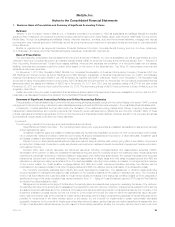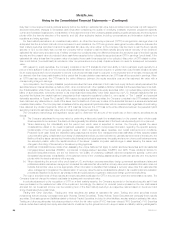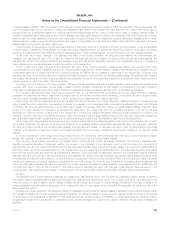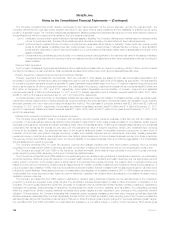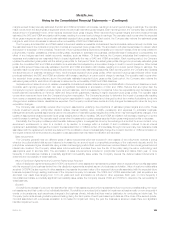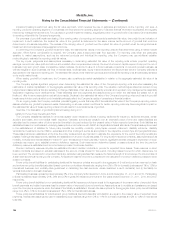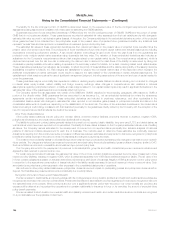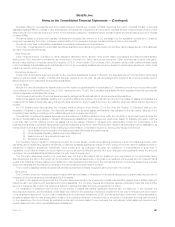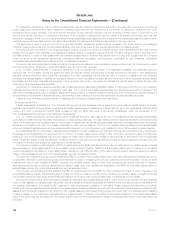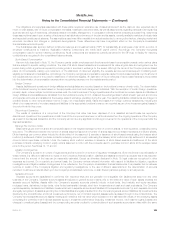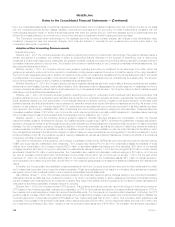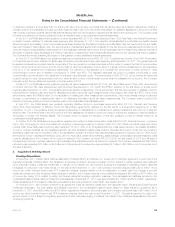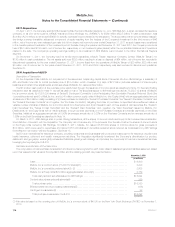MetLife 2011 Annual Report Download - page 109
Download and view the complete annual report
Please find page 109 of the 2011 MetLife annual report below. You can navigate through the pages in the report by either clicking on the pages listed below, or by using the keyword search tool below to find specific information within the annual report.MetLife, Inc.
Notes to the Consolidated Financial Statements — (Continued)
Future policy benefit liabilities for non-medical health insurance, primarily related to domestic business, are calculated using the net level premium
method and assumptions as to future morbidity, withdrawals and interest, which provide a margin for adverse deviation. Interest rate assumptions used
in establishing such liabilities range from 4% to 7%.
Future policy benefit liabilities for disabled lives are estimated using the present value of benefits method and experience assumptions as to claim
terminations, expenses and interest. Interest rate assumptions used in establishing such liabilities range from 2% to 9% for domestic business and 2%
to 9% for international business.
Liabilities for unpaid claims and claim expenses for property and casualty insurance are included in future policyholder benefits and represent the
amount estimated for claims that have been reported but not settled and claims incurred but not reported. Other policy-related balances include claims
that have been reported but not settled and claims incurred but not reported on life and non-medical health insurance. Liabilities for unpaid claims are
estimated based upon the Company’s historical experience and other actuarial assumptions that consider the effects of current developments,
anticipated trends and risk management programs, reduced for anticipated salvage and subrogation. The effects of changes in such estimated liabilities
are included in the results of operations in the period in which the changes occur.
Liabilities for universal and variable life secondary guarantees and paid-up guarantees are determined by estimating the expected value of death
benefits payable when the account balance is projected to be zero and recognizing those benefits ratably over the accumulation period based on total
expected assessments. The assumptions used in estimating the secondary and paid-up guarantee liabilities are consistent with those used for
amortizing DAC, and are thus subject to the same variability and risk. The assumptions of investment performance and volatility for variable products are
consistent with historical Standard & Poor’s (“S&P”) experience of the appropriate underlying equity index, such as the S&P 500 Index. The benefits
used in calculating the liabilities are based on the average benefits payable over a range of scenarios.
Future policy benefit liabilities are established for certain variable annuity products with guaranteed minimum benefits as described below under “—
Variable Annuity Guaranteed Minimum Benefits.”
The Company regularly reviews its estimates of actuarial liabilities for future policy benefits and compares them with its actual experience. Differences
between actual experience and the assumptions used in pricing these policies and guarantees, and in the establishment of the related liabilities, result in
changes in the additional liability balances with related charges or credits to benefit expenses in the period in which the changes occur.
PABs relate to investment-type contracts, universal life-type policies and certain guaranteed minimum benefits. Investment-type contracts principally
include traditional individual fixed annuities in the accumulation phase and non-variable group annuity contracts. PABs for these contracts are equal to:
(i) policy account values, which consist of an accumulation of gross premium payments and investment performance; (ii) credited interest, ranging from
1% to 13% for domestic business and 1% to 14% for international business, less expenses, mortality charges and withdrawals; and (iii) fair value
adjustments relating to business combinations.
Variable Annuity Guaranteed Minimum Benefits
The Company issues, directly and through assumed reinsurance, certain variable annuity products with guaranteed minimum benefits that provide
the policyholder a minimum return based on their initial deposit (i.e., the benefit base) less withdrawals. In some cases the benefit base may be
increased by additional deposits, bonus amounts, accruals or optional market value resets. These guarantees are accounted for as insurance liabilities
or as embedded derivatives depending on how and when the benefit is paid. Specifically, a guarantee is accounted for as an embedded derivative if a
guarantee is paid without requiring (i) the occurrence of specific insurable event, or (ii) the policyholder to annuitize. Alternatively, a guarantee is
accounted for as an insurance liability if the guarantee is paid only upon either (i) the occurrence of a specific insurable event, or (ii) annuitization. In
certain cases, a guarantee may have elements of both an insurance liability and an embedded derivative and in such cases the guarantee is accounted
for under a split of the two models.
These guarantees include:
‰Guaranteed minimum death benefit (“GMDB”) that guarantees the contractholder a return of their purchase payment upon death even if the
account value is reduced to zero. An enhanced death benefit may be available for an additional fee.
‰GMIB that provides the contractholder, after a specified period of time determined at the time of issuance of the variable annuity contract, with a
minimum accumulation of their purchase payments, even if the account value is reduced to zero, that can be annuitized to receive a monthly
income stream that is not less than a specified amount. Certain of these contracts also provide for a guaranteed lump sum return of purchase
premium in lieu of the annuitization benefit.
‰Guaranteed minimum withdrawal benefits (“GMWB”) that guarantee the contractholder a return of their purchase payment via partial withdrawals,
even if the account value is reduced to zero, provided that the contractholder’s cumulative withdrawals in a contract year do not exceed a certain
limit. Certain of these contacts include guaranteed withdrawals that are life contingent.
‰Guaranteed minimum accumulation benefits (“GMAB”) that provide the contractholder, after a specified period of time determined at the time of
issuance of the variable annuity contract, with a minimum accumulation of their purchase payments even if the account value is reduced to zero.
Guarantees accounted for as insurance liabilities in future policy benefits include GMDB, the portion of GMIB that require annuitization, and the life-
contingent portion of certain GMWB. These liabilities are established as follows:
GMDB liabilities are determined by estimating the expected value of death benefits in excess of the projected account balance and
recognizing the excess ratably over the accumulation period based on total expected assessments. The assumptions used in estimating the
GMDB liabilities are consistent with those used for amortizing DAC, and are thus subject to the same variability and risk. The assumptions of
investment performance and volatility are consistent with the historical experience of the appropriate underlying equity index, such as the S&P
500 Index. The benefit assumptions used in calculating the liabilities are based on the average benefits payable over a range of scenarios.
GMIB liabilities are determined by estimating the expected value of the income benefits in excess of the projected account balance at any
future date of annuitization and recognizing the excess ratably over the accumulation period based on total expected assessments. The
assumptions used for estimating the GMIB liabilities are consistent with those used for estimating the GMDB liabilities. In addition, the calculation
of guaranteed annuitization benefit liabilities incorporates an assumption for the percentage of the potential annuitizations that may be elected by
the contractholder. Certain GMIB have settlement features that result in a portion of that guarantee being accounted for as an embedded
derivative and are recorded in PABs as described below.
MetLife, Inc. 105


